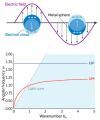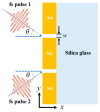Graphene-Based Plasmonic Antenna for Advancing Nano-Scale Sensors
- PMID: 40559306
- PMCID: PMC12195759
- DOI: 10.3390/nano15120943
Graphene-Based Plasmonic Antenna for Advancing Nano-Scale Sensors
Abstract
The integration of two-dimensional graphene with gold nanostructures has significantly advanced surface plasmon resonance (SPR)-based optical biosensors, due to graphene's exceptional optical, electronic, and surface properties. This review examines recent developments in graphene-based hybrid nanomaterials designed to enhance SPR sensor performance. The synergistic combination of graphene and other functional materials enables superior plasmonic sensitivity, improves biomolecular interaction, and enhances signal transduction. Key focus areas include the fundamental principle of graphene-enhanced SPR, the functional advantages of graphene hybrid platforms, and their recent applications in detecting biomolecules, disease biomarkers, and pathogens. Finally, current limitations and potential future perspectives are discussed, highlighting the transformative potential of these hybrid nanomaterials in next-generation optical biosensing.
Keywords: biomolecular interactions; hybrid nanomaterials; next-generation biosensing; plasmonic sensitivity.
Conflict of interest statement
The authors declare no conflicts of interest.
Figures












Similar articles
-
Recent Advances in Photonic Crystal Fiber-Based SPR Biosensors: Design Strategies, Plasmonic Materials, and Applications.Micromachines (Basel). 2025 Jun 25;16(7):747. doi: 10.3390/mi16070747. Micromachines (Basel). 2025. PMID: 40731657 Free PMC article. Review.
-
Advancing Frontiers: Graphene-Based Nano-biosensor Platforms for Cutting-Edge Research and Future Innovations.Indian J Microbiol. 2025 Mar;65(1):453-476. doi: 10.1007/s12088-024-01318-2. Epub 2024 Jul 6. Indian J Microbiol. 2025. PMID: 40371023
-
In Situ-Synthesized Gold Nanostructures (issAu) to Minimize Storage Constraints in Sensing Applications.ACS Sens. 2025 Jun 27;10(6):3806-3817. doi: 10.1021/acssensors.5c00928. Epub 2025 Jun 17. ACS Sens. 2025. PMID: 40526485 Review.
-
Graphene-based wearable biosensors for point-of-care diagnostics: From surface functionalization to biomarker detection.Mater Today Bio. 2025 Mar 14;32:101667. doi: 10.1016/j.mtbio.2025.101667. eCollection 2025 Jun. Mater Today Bio. 2025. PMID: 40568013 Free PMC article. Review.
-
Graphene-based biosensors for PSA.Clin Chim Acta. 2025 Aug 15;576:120406. doi: 10.1016/j.cca.2025.120406. Epub 2025 May 29. Clin Chim Acta. 2025. PMID: 40449708 Review.
References
-
- Sangwan A., Jornet J.M. Beamforming optical antenna arrays for nano-bio sensing and actuation applications. Nano Commun. Netw. 2021;29:100363. doi: 10.1016/j.nancom.2021.100363. - DOI
-
- Huang Y.H., Ho H.P., Wu S.Y., Kong S.K. Detecting phase shifts in surface plasmon resonance: A review. Adv. Opt. Technol. 2012;2012:471957. doi: 10.1155/2012/471957. - DOI
-
- Sirenko Y.K., Strom S. Modern Theory of Gratings. Resonant Scattering: Analysis Techniques and Phenomena. Springer; Berlin/Heidelberg, Germany: 2010.
Publication types
Grants and funding
LinkOut - more resources
Full Text Sources

